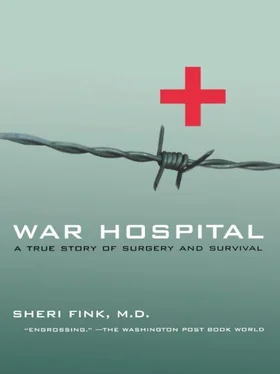PAGE 228 Going-away parties for MSF staff are fancy affairs… The description of the party in this section is based partly on photographs taken the summer of 1994. It’s not clear if it was Dr. Neak’s going-away party or a party celebrating some other occasion.
PAGE 230 Lindens are blooming… Translation of Lipe Cvatu , by Goran Bregović 1984. www.bisonmusic.com/zabe/brumovinotes.
PAGE 232 “Why are you expelling my guys from the hospital?” This exchange is based entirely on the recollection of Dr. Ilijaz Pilav.
CHAPTER 22: ANOTHER WORLD
Interviews
Dr. Sead Ahmetagić, Dr. Ejub Alić, Dr. Neak Duong, Elvira Duraković, Samira Duraković, Dr. Dževad Džananović, Hadžo Gadžo, Mensur Gadžo, Dr. Avdo Hasanović, Damir Ibrahimović, Dr. Gerry Kremer, Dr. Benjamin Kulovac, Dr. Irfanka Pašagić, Dr. Ilijaz Pilav, Dr. Wim Wertheim
Published Literature
NIOD Report: III/6/24 discusses military purpose of Bosnian helicopter flights and the shortage of weapons and military knowledge in Srebrenica; III/6/7 discusses NATO air strikes and UNPROFOR hostages used as human shields in May, 1995; III/2/4 and 5 describe the targeting of Captain Scott O’Grady’s F-16 with an SA-6 system; III/1 covers the debate over whether UNPROFOR should pull out of Bosnia.
Westmoreland et al., Medical Neurosciences, pp. 116–118 (about increased intracranial pressure). Mašić, Srebrenica, pp. 187–188 (covers the helicopter crash), 177 (story of the ambush near Srebrenica, which Mašić says occured on May 31, rather than June 1 as other sources have it). Honig and Both , Srebrenica, pp. 118–137 (history of Dutchbat in Srebrenica and its increasing difficulties in 1995). Kremer, “Medical neutrality in crisis control areas,” Medisch Contact, #45, November 8, 1996 (reviews Dutchbat medical work in Srebrenica and the case of the comatose woman). Holbrooke, To End a War, pp. 65–67, describes the U.S.’s major military commitment in the event that UNPROFOR pulled out of Bosnia.
Documents
Diary of a local (who wishes to remain anonymous) describing the helicopter crash. Anesthesia records of Srebrenica Hospital on day of Fatima’s injury. Report of the Secretary-General Pursuant to General Assembly Resolution 53/35 (1998), “UN Srebrenica Report” : Section 43 (describes how troop-contributing countries opposed robust military action resulting in a “lowest common denominator” response to atrocities), Sections 114–116 (the proposals to exchange Srebrenica and Žepa for Serb-held territory around Sarajevo), Section 222 (describes movements between Srebrenica and Žepa), Section 223 (June 1, 1995, Serb ambush and taking of the southern tip of the enclave, including Dutch surrender of OP Echo), Section 125 (difficulty of finding U.N. troops for safe areas), Section 233 (worsening humanitarian situation in Srebrenica by June 1995 and inability of Dutchbat to respond). MSF internal documents: MSF Srebrenica monthly report for October 1994 reports that Ilijaz is increasingly depressed, and he made and aborted plans to leave the enclave; July 7, 1994, Srebrenica interagency meeting agenda discusses goods and people being smuggled in and out of the enclave; May 13, 1994, MSF report about helicopter crash; MSF Srebrenica weekly situation report #21, May 27, 1995, describes Fatima’s wounding and military activity in and around Srebrenica.
European Community Monitoring Mission (ECMM) Weekly Report for May 4–11, 1995, tells of Bosnian Serb army shelling of Bosnian government military facility outside of Sarajevo.
Report of the Dutch Parliamentary Inquiry into Srebrenica, January 2003, describes the Dutch decision to send troops to Srebrenica.
International Criminal Tribunal for former Yugoslavia, case IT-98-33, “Prosecutor v. Radislav Krstić,” text of the August 2, 2001 judgement (from here on referred to as “Krstić judgment”) describes Dutchbat’s shrinking forces in early 1995 and the Dutchbat decision to allow Srebrenica forces to occupy shadow positions around observation posts.
Other Materials
Photograph of helicopter crash site (Mašić, Srebrenica, p. 167); Videotape footage taken by Dutchbat’s Dr. Gerry Kremer of the comatose patient in spring 1995 and of Fatima performing procedures at the Dutchbat hospital in Potočari, making good on her internal promise to do more surgery.
Notes
PAGES 233–234 International tension over Bosnia is high. Report of the Secretary-General Pursuant to General Assembly Resolution 53/35 (1998), “UN Srebrenica Report,” Section 124. Refers to the commander of UNPROFOR Bosnia-Herzegovina Command, who departed in December 1993.
PAGE 240 Inside, boxes fly. The account of the helicopter flight was based on the recollections of four witnesses who were either on the helicopter (Dževad), on the ground awaiting it (nurses Elvira and Samira Duraković), or at a Bosnian army base in radio contact with the pilots (Hadžo Gadžo).
Interviews
Dr. Ejub Alić, Mubina Alić, Dr. Mehdin Hadžiselimović, Dr. Ilijaz Pilav
Documents
Red Cross messages sent by Ejub Alić to Mubina Alić in 1994 dated January 6 (“I’m sending you a photograph… ”), July 12 (“I’m very hopeful…”), and July 17 (“Here love has become very cheap… ”). Letter sent to Mubina Alić via “Mad Max” dated July 26, 1993 (“People are evil… ”). These letters are among a group of several dozen kindly made available by the Alić’s to the author.
Other Materials
Home videotape of Srebrenica taken by Dr. Ejub Alić.
Notes
PAGE 252 The ugliness he saw led him to read his favorite author… Selimović, The Fortress, p. 7.
PAGE 256 On June 8… No other supporting documentation could be found to confirm the exact date of Ejub’s departure, which he estimates was June 8 or 9, 1995.
Interviews
Dr. Boro Lazić, Sanja Lazić, Damir Ibrahimović, Dr. Ilijaz Pilav
Published Literature
Agence France-Presse, June 12, 1995, describes military activity around Sarajevo and Bosnian government forces’ capture of Mt. Treskavica; Mašić, Srebrenica, p. 178 covers the June 24, 1995, attack on Vidikovac above Srebrenica hospital; NIOD III/5/11 provides details on the military plan, Krivaja 95 , including axes of attack (only one, from the southeast, was actually used) and command structure.
Documents
European Commission Monitoring Mission weekly reports provide details about the military activities around Sarajevo described in this chapter, in particular: April 21–27, May 4–11, May 11–18, and June 16–22, 1995.
Report of the Secretary-General Pursuant to General Assembly Resolution 53/35 (1998), “UN Srebrenica Report” : Sections 211–212 are about the attempts of Bosnian government forces to break the siege of Sarajevo; Section 225 describes Srebrenica soldiers’ June 26, 1995, attack on Višnjica, arguing that it was a diversionary offensive to draw Serb forces away from the Sarajevo attack, and providing details of Mladić’s response.
Krstić judgment describes the Srebrenica soldiers’ June 26, 1995, attack on Višnjica, arguing that it was a response to the Serbs’ capture of OP-Echo; it also details the Bosnian Serb army plan, Krivaja 95, stressing that the original objective was not, as Boro Lazić assumed, to capture the town, but to split Srebrenica and Žepa and possibly to reduce each enclave to its “urban core,” triggering a humanitarian crisis that would lead to an abandoning of the “safe area” concept.
Читать дальше












